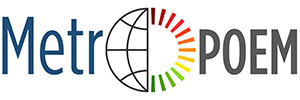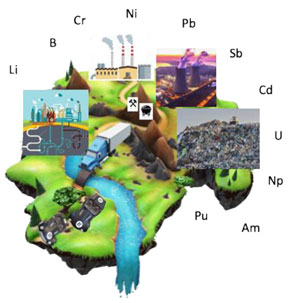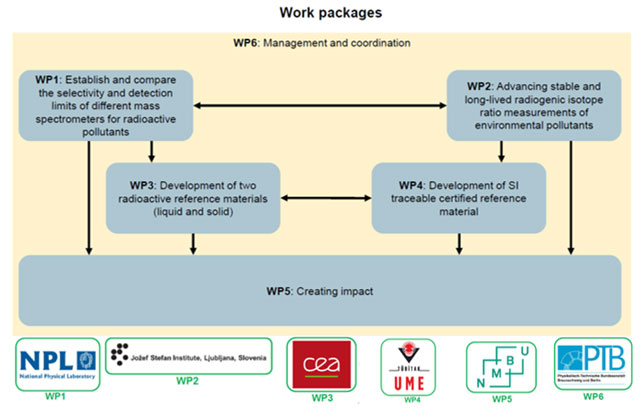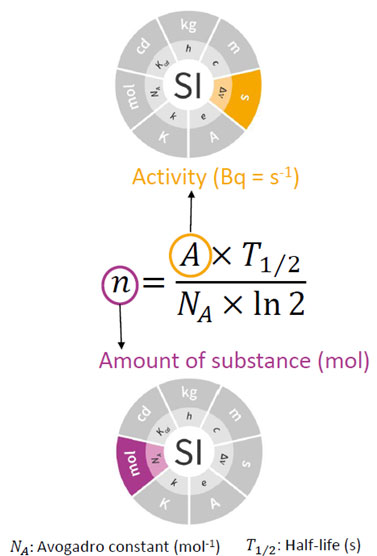Metrology for the harmonisation of measurements of environmental pollutants in Europe
 Overview
OverviewEuropean Green Deal’s ambition for zero pollution requires the development of highly sensitive techniques to detect ultra-low amounts of pollutants and to determine their isotope ratios. Mass spectrometry is a key method for non-radioactive polluting elements determination and is of increasing importance for long-lived radionuclides.
This project will bridge the gap between both methods and will establish new tools for tracing pollutants. Measurement uncertainties and detection limits will be significantly reduced using newly developed reference materials and SI-traceable measurement procedures with an immediate impact for tracking pollution sources by commonly available mass spectrometers.
The zero pollution ambition promoted by the European Green Deal, requires highly sensitive and state of the art detection techniques for the measurement of ultra-low amounts of pollutants.

Mass spectrometry is a key method, with high potential for reducing measurement uncertainties and detection limits. However, there is no existing traceability chain for radioactive elements and there is a lack of underpinning SI traceable isotope reference materials.
The proposed project the application of EU directives, regulations and the EURATOM treaty, the strategies described by two European Metrology Networks “Pollution Monitoring” and “Radiation” and joint efforts of CCRI and CCQM.
The overall goal is to extend and harmonise mass spectrometry measurement methods. The specific objectives are:
1. To establish and compare the selectivity and detection limits of different types of mass spectrometers (e.g. AMS, HR-ICP-MS, ICP-MS/MS, ICP-QMS, MC-ICP-MS, SIMS, SNMS, TIMS) for the radioactive pollutants U, Np, Pu, Am using single and mixed activity standard solutions. This includes assessing relative instrument performance with respect to current measurement challenges and establishing detection limits in relation to regulatory waste criteria levels or environmental regulations.
2. To develop measurement methods for isotope ratios, traceable to the SI by using multi-collector ICP-MS and apply these methods on more commonly available techniques (ICP-MS/MS, ICP-QMS) by providing suitable operating procedures focussing on stable polluting elements (e.g. Li, B, Cr, Cd, Ni, Sb, Pb, U). To produce recommendations for sample processing, treatment, uncertainty budgets, and the quantification of the mass bias.
3. To develop two radioactive reference material with the sample matrix containing radioactive pollutants (e.g. U, Np, Pu, Am) for use in an inter-laboratory comparison employing techniques used in objective one, which will demonstrate the variations in parameters including detection
limits, sample preparation requirements, sample introduction methods, total procedural time, and uncertainty budgets.
4. To implement and validate the methods for isotope ratio measurements established in objective 2 by the development of one aqueous certified reference material that is certified for the same stable polluting elements with lowest possible uncertainties using multi-collector instruments in order to facilitate the calibration of single collector ICP-MS, instrument validation, as well as quality control.
5. To facilitate the take up of the technology and measurement infrastructure developed in the project by the measurement supply chain (e.g. accredited laboratories), standards developing organisations and international organisations (JRC, CIPM CCs [CCQM-IRWG, CCQM-IAWG, CCRI], IAEA, ICRM) and end users (e.g. environmental monitoring agencies).


This project will enable and harmonise measurement methods for the detection and characterisation, of both radioactive isotopes and stable polluting elements, in support of the EU Green Deal's aim toward a zero pollution, toxic-free environment. The measurement of the species in this project (Li, B, Cr, Ni, Cd, Sb, Pb, U, Np, Pu and Am) will benefit the users of such data, such as monitoring organisations and the owners of potentially polluting facilities. This project, by providing information to the ICP-MS (of whatever type) measurement community, will allow them to select the most appropriate technology (from AMS, HR-ICP-MS, ICP-MS/MS, ICP-QMS, MC-ICP-MS to single collector ICP-MS) to meet their needs. As a result, users seeking to invest in one of the available ICP-MS based modalities will be able to make informed decisions. The Europe-wide collaboration developed in the project will provide the foundation for future inter-laboratory comparison exercises for the determination of species of interest in a variety of environmental matrices where ICP-MS based techniques offer significant advantages over decay counting. The new RMs developed in this project will address the ongoing need to produce suitable and relevant (in terms of matrices and analytes) RMs that can validate state-of-the-art measurement capabilities.
Outcomes for the metrology and scientific communities
The scientific outcome of the proposed research will deliver validated and traceable analytical approaches for the analysis of the concentration of pollutants, as well as determining the source and monitoring any contamination of pollutants through isotope ratio measurements. This will close existing metrological gaps and will lead to a harmonisation of the different methods currently applied for the analysis of isotope ratios to support the investigation of natural environmental processes and anthropogenic impacts.
Combining the expertise in isotope ratio measurements of the Comité Consultatif pour la Quantité de Matière: métrologie en chimie et biologie (CCQM) and radioactivity measurement by the Comité Consultatif des Rayonnements Ionisants (CCRI) will provide new and innovative tools for advancing the application of mass spectrometry for contributing to improved half-life determinations.
Outcomes for relevant standards
This project will deliver an improved system of metrology and will establish an infrastructure that directly supports the application of the following EU regulations or EU directives:
• Council Directive 2013/51/Euratom (22 October 2013): requirements for protecting the health of the general public concerning radioactive substances in water intended for human consumption.
• Council Directive 2013/59/Euratom (5 December 2013): basic safety standards for protection against the dangers arising from exposure to ionising radiation; Chapter VIII – Public Exposures.
• Treaty establishing the European Atomic Energy Community, Chapter III – Health Protection, Article 35: Each Member State shall set up the facilities necessary for the permanent control of the level of radioactivity in the atmosphere, water and soil and for controlling compliance with basic standards. The Commission shall have the right of access to such control facilities; it may examine their operation and efficiency.
• EU Regulation 995/2010: the origin of legal timber by, for example, determining the Sr isotope composition.
• EU Regulation 2729/2000, 2220/2004, 2030/2006, 555/2008 and 1169/2011: the provenance of food.
• Directive 2009/29/EC, decision No 406/2009/EC, directive 2009/31/EC: Climate research (δ11B), greenhouse gases (pathways of δ13C), carbon storage (possibly applicable for the geological assessment of Sr and Nd).
By implementing new traceability chains, different methods will be combined in the field of pollution monitoring, which will then lower the detection limits. This will result in better protection of the environment, provide new tools for complex studies in climate observation, support validated data collection of the European Research Centres and enhance the implementation of the ALARA goal expressed in the radiation protection regulation of the EC.
Longer-term economic, social and environmental impacts
The integration of highly specialised MS techniques, such as Accelerator Mass Spectrometry/Spectrometer (AMS) and Secondary-Ion Mass Spectrometry/Spectrometer (SIMS), into the project, considerably widens the horizon for environmental monitoring or forensic studies and harmonises these detection methods with more commonly applied ICP-MS methods. The outcomes of the project will contribute to meeting the challenge of achieving highly sensitive and cost-effective pollution control. Using ICP-MS techniques in routine pollution monitoring allows the rapid determination of multiple elemental pollutants (both radioactive and stable) within a single sample. This ability, linked to the automated high sample throughput of ICP-MS systems, allows the capture of more and better sample information from single measurements. These factors will help to make a rapid and detailed mapping of pollutants, within defined areas, relatively straightforward. As a result, remediation strategies can be closely targeted and operated with good resolution. The cost of these activities will be reduced without losing effectiveness.
The development of validated and traceable methods will improve societal confidence in the measurement and quantification of pollutants across many sectors, such as manufacturing, industrial decommissioning and the long-term decommissioning and remediation of aged and disused nuclear sites. Accurate waste classification engenders public confidence and ensures inventories are correct for future infrastructure planning, such as the scale and design of pollutant remediation programmes.
The outputs from the project may be employed in several diverse fields including routine real-time monitoring, emergency response, geological dating and climate change studies through isotopic ratio measurements, and in other activities, such as nuclear forensics, decommissioning non-nuclear industries (such as the oil industry in the North Sea) and radiopharmaceutical facilities, where use is made of long-lived radioactive precursors. The collaboration between European laboratories established in this project is expected to continue beyond the end of the project.
Our research and measurement solutions support innovation and product development. We work with companies to deliver business advantage and commercial success.
Contact our Customer Services team on +44 20 8943 7070